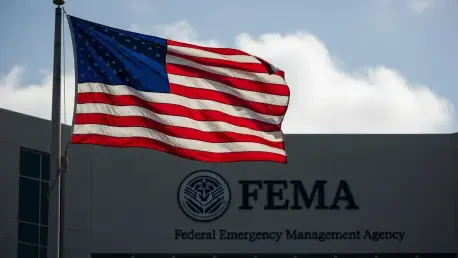Imagine a Category 5 hurricane barreling toward the Gulf Coast, leaving millions in its path scrambling for safety, while communities brace for impact and a pressing question looms: who will lead the charge in disaster response—federal agencies like FEMA, or state and local governments stepping into a larger role? Amid rising natural disasters driven by climate change, the debate over the Federal Emergency Management Agency’s future has ignited fierce discussion among lawmakers, state leaders, and emergency management professionals. This roundup gathers diverse perspectives on whether states could replace FEMA, exploring reform proposals, radical restructuring ideas, and the implications for national preparedness. The purpose is to distill insights from multiple stakeholders to shed light on this critical issue facing disaster management today.
Diverse Voices on FEMA’s Role and Future
Criticisms of FEMA Shared Frustration
Across political divides, there’s a notable consensus that FEMA struggles with inefficiencies that hinder effective disaster response. Many federal lawmakers point to bureaucratic red tape as a primary culprit, often delaying critical aid to devastated communities. Complaints frequently center on slow reimbursement processes for local governments handling debris removal and other recovery costs, painting a picture of an agency bogged down by its own structure.
State officials echo these concerns, highlighting instances where federal support arrived too late to make a meaningful difference. Rural areas, in particular, feel neglected, as resources seem disproportionately allocated to urban centers during crises. This shared frustration sets the stage for calls to rethink how disaster management operates at a national level.
The depth of dissatisfaction varies, though, with some stakeholders arguing that these issues are fixable through targeted reforms, while others see them as evidence of a fundamentally flawed system. This split in opinion fuels the broader debate on whether to enhance FEMA or shift its responsibilities elsewhere.
Reform vs. Restructuring: Congressional Perspectives
On Capitol Hill, a bipartisan push for reform has gained traction, with legislation aiming to elevate FEMA to a Cabinet-level agency for greater authority and streamlined operations. Proponents argue that this structural change would prioritize disaster management at the highest governmental level, ensuring quicker decision-making during emergencies. Additional proposals focus on mitigation projects to lessen disaster impacts before they strike, a move seen as proactive rather than reactive.
However, not all lawmakers agree on preserving FEMA’s central role. Some Republican voices advocate for a leaner federal presence, suggesting that state-led responses could be more agile if supported by federal block grants. This perspective emphasizes local knowledge as a key asset in tailoring recovery efforts to specific regional needs, though it raises questions about consistency across the nation.
The tension between these two approaches—reform versus a fundamental shift—reveals a deeper divide on federal-state dynamics. While reformists seek to strengthen an existing framework, others question if a federal safety net is even necessary in its current form, pushing for a reimagined balance of power.
State and Local Leaders Weigh In on Capacity Concerns
State and local officials bring a grounded perspective to the table, often expressing apprehension about taking on greater disaster response duties without robust federal backing. Leaders from smaller or economically strained regions highlight their limited budgets, warning that self-reliance could lead to higher taxes or inadequate preparation for large-scale crises. This concern is particularly acute in areas unaccustomed to frequent natural disasters.
Urban representatives, while often better resourced, note the immense financial strain of managing recovery without consistent federal funding. They argue that immediate response might fall within local purview, but long-term rebuilding—such as infrastructure repair—requires expertise and money that only a federal agency can reliably provide. This viewpoint underscores a dependency on centralized support for complex recovery phases.
A recurring theme among these leaders is the need for clarity in cost-sharing agreements between federal and state entities. Without a defined framework, many fear being left to shoulder burdens beyond their capacity, potentially exacerbating disparities in disaster readiness across different regions of the country.
Trump Administration’s Vision: A State-Centric Model
Insights from the current administration reveal a starkly different approach, with proposals to potentially dismantle FEMA in favor of a model where states take the lead, supported by federal block grants. This vision prioritizes local control, positing that states are better positioned to understand and address their unique challenges during disasters. The idea is to reduce federal overreach, allowing for more tailored and immediate action.
Critics of this plan, however, caution against the uneven capabilities among states to handle such responsibilities. Smaller or less experienced regions might struggle without the federal expertise and coordination that FEMA currently offers, leading to inconsistent outcomes nationwide. This concern is amplified by the potential for block grants to be insufficient or misallocated under varying state priorities.
The debate surrounding this state-centric model also touches on equity, as stakeholders question whether all communities—especially those with fewer resources—would receive adequate support under a decentralized system. This perspective challenges the assumption that reducing federal involvement inherently leads to better results.
Funding Dilemmas: Who Pays for Disaster Response?
Financial considerations form a critical part of this discussion, with significant debate over FEMA’s budget and how disaster response should be funded. Congressional committees have proposed substantial allocations, upwards of $31 billion, to bolster the agency’s capabilities, reflecting a commitment to maintaining a strong federal role. This funding is seen as vital for both immediate aid and long-term recovery initiatives.
Opposing views, however, suggest redirecting these funds into block grants or other mechanisms that prioritize state autonomy. Some argue that federal budgets could be trimmed if states assume more responsibility, though this sparks fears of reduced overall support for disaster-prone areas. The risk of fund misdirection under new administrative priorities adds another layer of uncertainty to the conversation.
State and local input often focuses on the strain on local budgets when federal support wanes. Many officials stress that without guaranteed funding, communities might face impossible choices between disaster preparedness and other essential services, highlighting the need for a sustainable financial model that bridges federal and state contributions.
Key Takeaways from the Roundup
Looking back, this roundup captured a spectrum of opinions on FEMA’s future, from bipartisan reform efforts in Congress to the administration’s push for a state-led disaster response model. The discussions revealed a shared acknowledgment of FEMA’s shortcomings, yet a sharp divergence on solutions—whether to enhance the agency’s structure or shift burdens to states. State and local leaders provided critical insights into capacity and funding challenges, while financial debates underscored the stakes of reallocating resources. Moving forward, stakeholders are encouraged to advocate for balanced federal-state collaboration, prioritizing clear cost-sharing frameworks to ensure equitable support. Further exploration of disaster management policies through legislative updates and state-level preparedness reports can offer deeper understanding, guiding the nation toward a resilient future in the face of escalating natural calamities.









